Horn Hunting the High Country
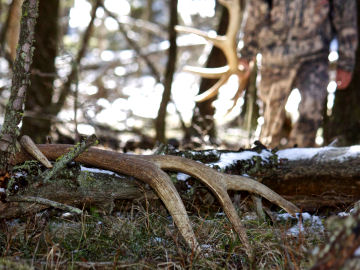
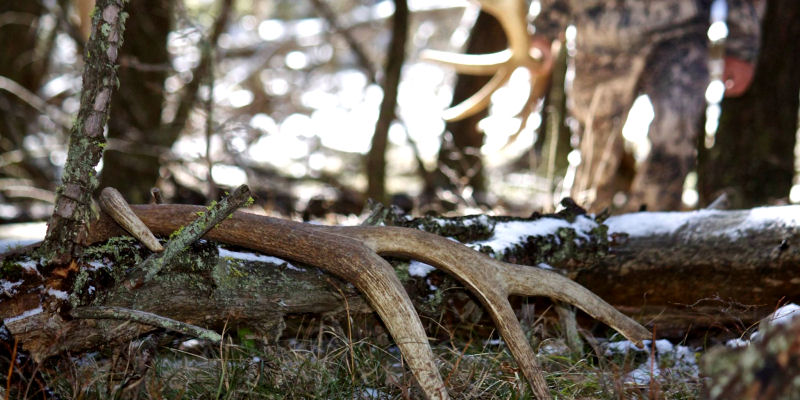
This featured article is written by guest contributor, Alec Pinero. All images by Alec Pinero.
As winter shifts to spring in elk country, antlers begin hitting the ground and men and women across the west become filled with excitement, anticipation, and decisions. The two most difficult decisions a shed hunter will face are where to go, and when to put the boots on the ground. As a novice, it can be difficult to make the right decisions. Shed hunting for mature bull elk may be a tough code to crack, but with the right mindset, you can crack that code in one season.
Shed hunting is one of those sports that has become very popular in a short period of time. Because of this, very little information is out there on how to shed hunt. On top of this, nearly all of the advice is the same, and this leaves beginning shed hunters all doing about the same thing.
Think about it, how many times have you heard, “Hit the south slopes, go to snowline, find the big winter herds etc. etc. etc.” I know that when I first shed hunted a couple years ago, this was all I heard, and therefore that was all I did. I am not disagreeing with this simple strategy, but I would like to say that this is a very incomplete way to view shed hunting. The following discusses my experience with cracking the code, and how I view shed hunting after a few years of experience.
Where to go and When to go
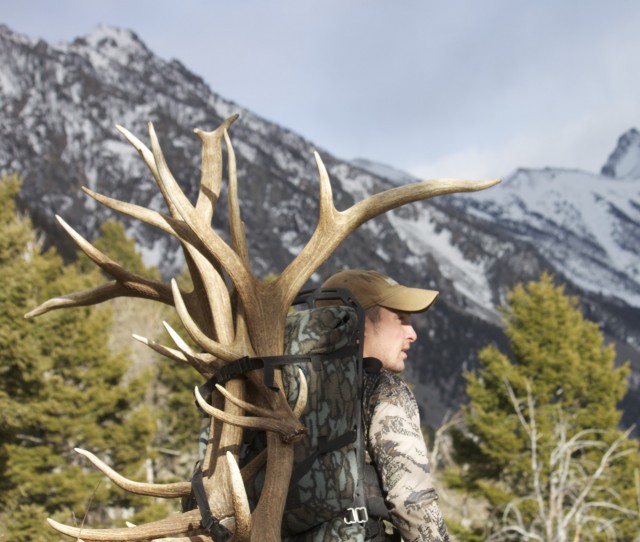 To me, where to go and when to go are completely dependent on each other. If I was fortunate enough to shed hunt on private land, when to go would be easy. I would simply start in May. If I go in April, I may spook bulls off the property before they even shed. If I go in June, the grass will be much taller, and some antlers inevitably get chewed up by vermin. However, I am a poor college student who finds National Forest as my only option. Because I have to factor in pressure, where and when to go are completely dependent on each other. I find my areas, and I hunt them at different times throughout the spring based on the situation. Simply put, I start hiking the pressured areas first, and go to more remote areas as the spring progresses. However, I start my shed hunting season behind the glass, so this means my hunt starts in February.
To me, where to go and when to go are completely dependent on each other. If I was fortunate enough to shed hunt on private land, when to go would be easy. I would simply start in May. If I go in April, I may spook bulls off the property before they even shed. If I go in June, the grass will be much taller, and some antlers inevitably get chewed up by vermin. However, I am a poor college student who finds National Forest as my only option. Because I have to factor in pressure, where and when to go are completely dependent on each other. I find my areas, and I hunt them at different times throughout the spring based on the situation. Simply put, I start hiking the pressured areas first, and go to more remote areas as the spring progresses. However, I start my shed hunting season behind the glass, so this means my hunt starts in February.
Develop a Pre-season Strategy
All winter long I look through google maps, property maps, topographic maps, and elk studies to develop a list of potential shed hunting areas. By mid-February I quit the search for deer sheds and begin glassing the potential elk shedding areas I found during winter. I used to be like most people and keep tabs on the monstrous herds, but now I focus my time glassing for individuals and small groups. When I made the switch, I first started by finding the big herds, and then I would simply glass above them.
As we have all heard, “elk are where the elk are,” but during spring I like to think, “the bulls are where the bulls are.” Yes, it’s quite easy to find the cow herds, but finding cow herds is not the same as finding bulls. A few mature bulls may stay with the cows, but most will head into the high country as soon as possible. Add public land pressure to the equation and you will have bulls pushing through chest deep snow drifts just to have a little bit of peace. Try watching private land bulls in late winter. Even they will head up high for no particular reason, but simply out of their nature.
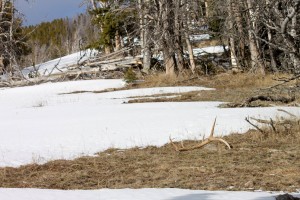 Your strategy on how to find these bulls depends on what you have already seen. If you have been watching bulls long enough to see them shed, then great, because you know where and when to go. If this is not the case, then your second best option is to find the trails in the early part of the season. I’ve found a few sheds while following trails in the deep snow, but if anything, this gives you an idea on where to shed hunt for the weeks and months to come.
Your strategy on how to find these bulls depends on what you have already seen. If you have been watching bulls long enough to see them shed, then great, because you know where and when to go. If this is not the case, then your second best option is to find the trails in the early part of the season. I’ve found a few sheds while following trails in the deep snow, but if anything, this gives you an idea on where to shed hunt for the weeks and months to come.
It is very important to find out where the bulls are every year, as each year is different. Honey holes often produce, but the only true way to tell where the elk are shedding is by studying them during the winter months.
Putting Boots on the Ground
Hit the Primary Spots First
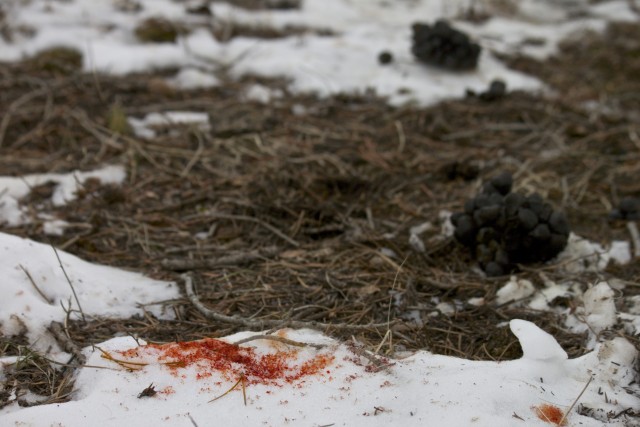 Once I’ve found where the bulls are, the rest is pretty easy. I don’t focus on the south slopes, sagebrush, nor anything else for that matter. I simply walk around and find the sign. Sheds are usually easy to spot on the south slopes because they are usually more open, but I usually find the sign dispersed equally on north, east, and west slopes. Elk use nearly ever side of the mountain, but the elk pattern differently depending on the intensity of the winter. If the snowpack is heavy, the elk tend to use the south slopes more heavily than the others. If the snowpack is light, you will see more sign in the timbered snowy slopes. This year was a warm one, and I found one of my best sets after following two sets of bull tracks on a shaded north slope. I followed the track for 3.7 miles as they pulled me through 4 foot snow drifts and nasty fallen timber. They lead me through a thawed north-slope bench, and soon after I spotted the 7×6 match. The elk had me walking a circle, and by the end I was only about a mile from the truck! I was lucky enough to find the track in the snow. Had I gone to this drainage a month later after the thaw, I would have never thought to look as close as one mile from the parking lot, considering that there are a half dozen rigs parked there every weekend.
Once I’ve found where the bulls are, the rest is pretty easy. I don’t focus on the south slopes, sagebrush, nor anything else for that matter. I simply walk around and find the sign. Sheds are usually easy to spot on the south slopes because they are usually more open, but I usually find the sign dispersed equally on north, east, and west slopes. Elk use nearly ever side of the mountain, but the elk pattern differently depending on the intensity of the winter. If the snowpack is heavy, the elk tend to use the south slopes more heavily than the others. If the snowpack is light, you will see more sign in the timbered snowy slopes. This year was a warm one, and I found one of my best sets after following two sets of bull tracks on a shaded north slope. I followed the track for 3.7 miles as they pulled me through 4 foot snow drifts and nasty fallen timber. They lead me through a thawed north-slope bench, and soon after I spotted the 7×6 match. The elk had me walking a circle, and by the end I was only about a mile from the truck! I was lucky enough to find the track in the snow. Had I gone to this drainage a month later after the thaw, I would have never thought to look as close as one mile from the parking lot, considering that there are a half dozen rigs parked there every weekend.
Finding Secondary Spots
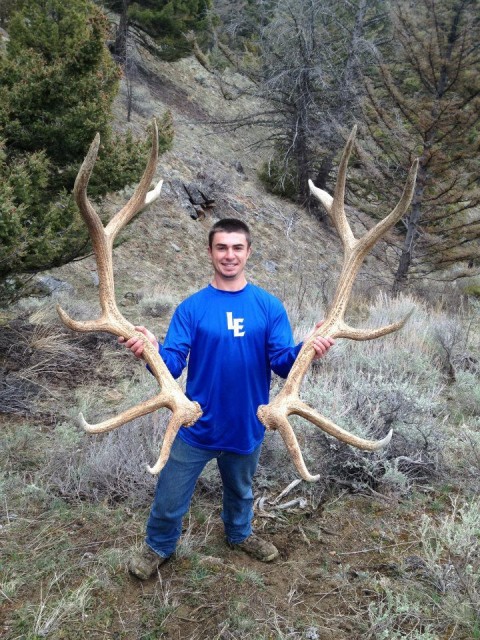 Once the snow melts, it is quite difficult to figure out which north slopes the bulls are bedding on and moving through. If I have walked all the areas I have studied, it is time to change tactics. Now is the time to start putting on those miles. My late season shed hunting strategy is to find open slopes that are very high, and very deep. The easily accessible south slopes have been hit hard by now, and though you still might find handfuls of sheds, they will most likely be raghorns. During the late season I scan areas quickly, and glass large chunks of land. I’m really just trying to find one big shed. Only after that will I thoroughly pick apart the surrounding north, east, and west slopes for additional sheds.
Once the snow melts, it is quite difficult to figure out which north slopes the bulls are bedding on and moving through. If I have walked all the areas I have studied, it is time to change tactics. Now is the time to start putting on those miles. My late season shed hunting strategy is to find open slopes that are very high, and very deep. The easily accessible south slopes have been hit hard by now, and though you still might find handfuls of sheds, they will most likely be raghorns. During the late season I scan areas quickly, and glass large chunks of land. I’m really just trying to find one big shed. Only after that will I thoroughly pick apart the surrounding north, east, and west slopes for additional sheds.
If All Else Fails
If all else fails, just walk. As simple as it sounds, this is my greatest piece of advice. My best tip for finding rag horns is to hit sage brush covered south slopes, but my best tip for finding the big antlers is to simply walk wherever you please. The largest sheds I’ve ever found were in areas that you could not glass, and in areas that you would never think of shed hunting. One of my best sheds was found in a nasty bottom filled with nothing else but moose sign, and another one was in a thick nasty patch of timber less than a mile from the road. Like finding mature bulls during hunting season, the key to shed hunting is often to walk where others don’t walk.
Let me help you with that. Have you ever been on Google Earth and thought, “Wow, that nasty north slope is just a mile from the road but looks killer to shed hunt!” I didn’t think so. However, if you take that advice to heart, you can plan on finding fewer sheds; but you can also plan on finding fewer boot tracks, as well as what we all are looking for: bigger elk sheds!

